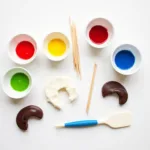Vermilion, a color steeped in history and rich in symbolism, often sparks curiosity. What exactly is this captivating color, and how does it differ from other reds? Let’s delve into the world of vermilion, exploring its origins, characteristics, and versatile uses.
Unveiling Vermilion: A Color From the Earth
Vermilion is a vivid, scarlet red pigment, historically derived from the mineral cinnabar, a naturally occurring form of mercury sulfide. Its name originates from the Old French word “vermeillon,” meaning “little worm,” referencing the insect used to create a similar red dye.
For centuries, vermilion held immense value due to its scarcity and brilliant hue. It graced the palettes of renowned artists like Michelangelo and Rembrandt, adding depth and luminosity to their masterpieces.
Deciphering the Color: A Warm and Powerful Red
Vermilion is often described as a warm, bright red with subtle orange undertones. Its vibrancy distinguishes it from cooler reds like crimson, which lean towards blue. This distinct warmth evokes a sense of energy, passion, and even a touch of regality.
Imagine the dramatic sunsets painted across the sky, or the fiery petals of exotic flowers – these natural wonders embody the captivating essence of vermilion.
Vermilion Through the Ages: Symbolism and Significance
Historically, vermilion’s use extended beyond art. Its rarity and cost associated it with power and prestige. In ancient Rome, it adorned the shields of victorious generals and the robes of emperors. In China, it symbolized good fortune and longevity, featuring prominently in traditional lacquerware and temples.
Even today, vermilion retains its symbolic weight. It represents courage, passion, and a zest for life. It can be a bold statement in interior design, adding vibrancy and warmth to any space.
Vermilion in the Modern World: Art, Design, and Beyond
While synthetic alternatives have largely replaced natural vermilion due to toxicity concerns, the color continues to captivate. Artists and designers appreciate its ability to add drama, warmth, and a touch of history to their work.
From fashion to interior design, vermilion makes a statement. Imagine a vibrant vermilion accent wall adding personality to a living room, or a striking vermilion scarf adding a pop of color to a neutral outfit.
Exploring Vermilion: Frequently Asked Questions
1. What is the difference between vermilion and scarlet?
While both are vibrant reds, vermilion leans towards orange, while scarlet has a slight pink undertone.
2. Is vermilion still used in art supplies?
Modern art supplies generally use safer, synthetic alternatives to natural vermilion pigment.
3. Can I use vermilion in my home decor?
Absolutely! Vermilion can add energy and personality. Consider using it for accent walls, furniture, or decorative accessories.
4. What colors complement vermilion well?
Vermilion pairs beautifully with neutrals like gray, white, and black. It also creates striking contrasts with cool blues and greens.
5. Where can I find vermilion paint or fabric?
Most paint and fabric stores offer a wide range of reds, including shades close to vermilion. Be sure to ask for samples to ensure the color matches your vision.
Beyond Vermilion: Expanding Your Color Palette
Understanding the nuances of vermilion opens a door to a wider appreciation for the power of color. From its historical significance to its modern applications, vermilion continues to inspire and intrigue.
Looking to explore other colors and how to incorporate them into your world? Learn more about what color is Miles Morales’ jacket, how to describe the color red, or discover how to make a peach color with paint. Our world is a canvas waiting to be painted with the hues that speak to you.
Need help creating your ideal space with color? Contact Color Box Hanoi today at 0373298888 or SEO.backlink@gmail.com. Our team of color experts is here to guide you every step of the way. Visit us at 86 Cầu Giấy, Hà Nội, and let us help you transform your vision into a reality.
